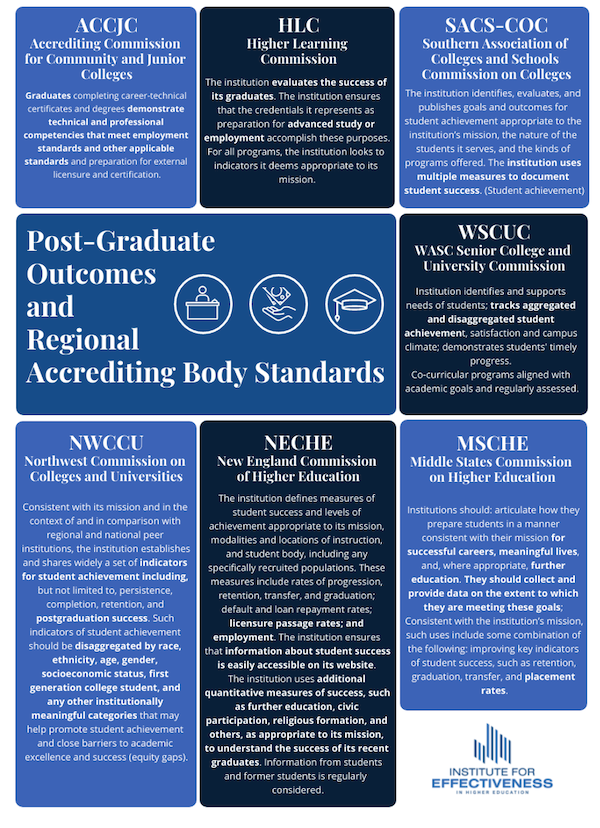Published on
Post-Graduation Metrics: Considerations When Telling Your Institution’s Student Success Story

Introduction
Analyses of the current workforce indicate that there are not enough workers to fill all the open positions. In economic terms, there is a shortage of supply.
If that is the case, then it is unlikely that employment rates will tell the full story of student success after college.
This article explores the post-graduation metrics (beyond employment rates) that institutions could easily track to tell their student success story to key external audiences, such as accreditors. Considerable work has already been done on post-graduation metrics. This article highlights and builds off those key resources.
Postsecondary Outcomes
Whether in a home, a college or a legislative body, the same question has echoed through the ages: What exactly are colleges graduates up to?
While the outcome of interest depends on the voices asking the question, there is one unifying concern: time. You see, our world is defined by time; it is the one constant that cuts across everything. And, among those who have completed college, there is a belief that their time is more valuable than when they started. Now, the ways we measure this assertion varies, but it is at the heart of every decision.
The federal student aid system was built on time. That is how the Cost of Attendance was developed—economists argued that for every hour a student was in class, they were not working and therefore losing money. So, federal student aid had to compensate for lost wages to allow students to attend college.
Time is also the standard unit of measurement–the Carnegie unit–and for credit hours or time spent in class. So, it should follow that the outcomes of postsecondary education are also concerned with time—more specifically, how valuable one’s time has become.
Value extends beyond money. Take, for example, a graduate of an accounting program employed as a certified public accountant. You may imagine a woman at an orderly desk, her computer connected to two monitors with spreadsheets open, the glow from the screen lighting up the glasses on her face. What you likely did not imagine is this accountant at 6 PM, sitting on the sidelines of a soccer field, collecting money for a youth soccer program, applying her accounting skills in service of everyone on the team—for free.
Embedded within this one example is a persistent, consistent framework to understand the outcomes of postsecondary education.
This framework is a simple matrix that positions postsecondary outcomes in one of four quadrants. Along the top are two boxes, one for monetary returns to society and another for monetary returns to individuals. Similarly, the bottom row of boxes illustrates the non-monetary returns to society and the non-monetary returns to individuals. This framework is not new—in fact, it has been around for decades and most recently applied to such high-profile projects, like “Advancing a Comprehensive Study of Post-Collegiate Outcomes” led the by public higher ed associations, the Bill & Melinda Gates Foundation’s Postsecondary Value Commission or Lumina Foundation’s Unlocking the Nation’s Potential taskforce report. The data used to put each of these quadrants into operation have been the topic of endless study, refinement and design.

For a host of reasons, each measure is perfectly imperfect. Some are elusive to collect and others are available from governmental agencies just starting to break down longstanding siloes to better inform our collective understanding.
By taking the measures, the echoes down the hall no longer ring hollow. Rather, they are now met with a response, an ensuing dialogue and a chance to learn more about articulating the value of postsecondary education beyond monetary returns to individuals. The next section focuses on one audience–accreditors–that has integrated post-college outcomes into their standards and anticipated the impact of labor shortages on colleges and universities.
Post-Graduation Outcomes in Accreditation
One way in which colleges and universities articulate the value of postsecondary education is through accreditation processes (e.g., regional accreditation). Evidence of student success is a required part of the institution’s accreditation report. A review of the seven regional accrediting bodies’ standards demonstrates the importance of post-college outcomes–both monetary and non-monetary (relevant excerpts below).

Monetary returns to individuals, such as employment rates and salaries, are among the most common post-graduate outcome metrics that institutions use. Higher education institutions spend a ton of time and energy on tracking their graduates’ employment status because employment data is stored in governmental databases within federal and state agencies and state unemployment offices, which can be difficult to access. Colleges and universities therefore often collect information on their own, usually through graduation surveys.
The pandemic has had an impact on everything, including post-college outcome metrics. You’ve probably seen or experienced the recent and growing labor shortage. There are simply more jobs than trained workers at the moment. Many analysts forecast an employee’s job market for quite some time. Assuming this is the case (and all data suggest it is), perhaps we can increase focus on employment and bring other post-college outcomes to the forefront.
Do the jobs have benefits that reduce the need for public services? Are graduates satisfied in their new work environments? How are graduates engaging with cultural events? Are graduates volunteering to improve the conditions in their community?
Perhaps hallway conversations will indeed shift to answer questions like these that help stakeholders to understand how to define post-graduation success. And it will likely extend beyond employment rates or graduate school acceptance. Maybe colleges and universities will take this moment to track metrics that matter more to their key stakeholders in earnest. As seen in the excerpts from the accreditation standards, there already is an acknowledgement of the need for this shift, so now it is time for institutions to act.
Key Takeaways and Action Steps
There is no one single post-college outcome metric to track. Rather, it is the composition of metrics from each quadrant that helps to tell an institution’s student success story. The good news is that post-college outcomes have been a focus of study for decades, and strong resources already exist. To help institutions get started in expanding their post-college outcome metrics, a few favorite resources include:
- Advancing A Comprehensive Study of Post-Collegiate Outcomes, March 2015
- Community College Contributions, July 2013
- Education Pays 2019: The Benefits of Higher Education for Individuals and Society, January 2020
- Equitable Value: Promoting Economic Mobility and Social Justice Through Education, May 2021
- Of Metrics and Markets: Measuring Post-College Employment Success, December 2018
- Postgraduate Outcomes of College Students, 2016
- The Economic Value of College Majors, 2015
- Unlocking the Nation’s Potential, 2019
Disclaimer: Embedded links in articles don’t represent author endorsement, but aim to provide readers with additional context and service.
Author Perspective: Analyst



